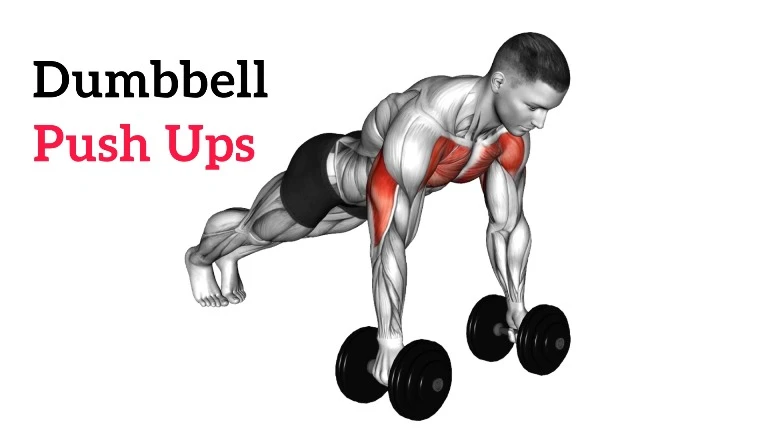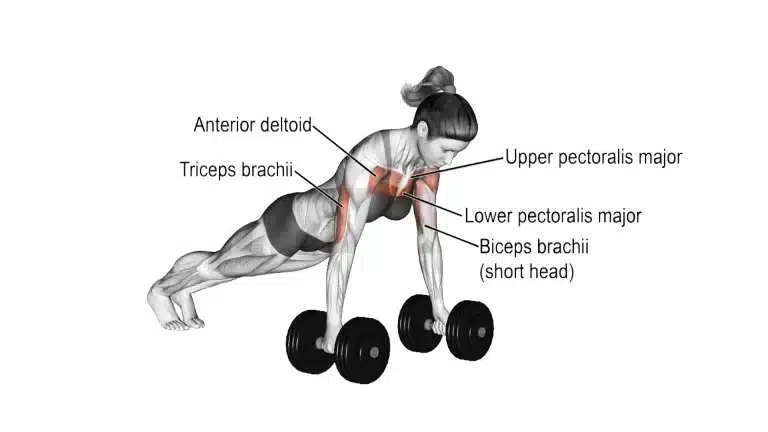Dumbbell push-ups are a variation of the traditional push-up exercise.
Dumbbells allow a neutral grip, unlike a traditional push-up with a fixed, often hyperextended wrist position. So, for those who experience discomfort during standard push-ups, they help reduce stress on the wrist joint capsule and surrounding ligaments.
They also allow for a deeper eccentric (lowering) phase, which means your muscles are involved, especially in the chest, triceps, and shoulders.
And balancing on two potentially unstable objects (especially non-hexagonal dumbbells, though hex is safer) significantly increases the demand for stabiliser muscles, including the core, shoulder rotators, and even wrist/forearm stabilisers.

Dumbbell Push-Ups Muscles Worked
Dumbbell push-ups primarily work the chest muscles (pectoralis major and minor), triceps, and front of the shoulders (anterior deltoids).
They also engage the core, back, and serratus anterior muscles, which help stabilize the body during exercise.

Here’s how these muscles are engaged during the dumbbell push-up:
- Chest muscles: The chest muscles are responsible for moving the arms and shoulders, and they’re activated as you push your body away from the wall.
- Triceps: The triceps are the muscles on the back of the upper arm, and they’re responsible for extending the elbow. They’re engaged as you straighten your arms during the push-up.
- Shoulders: They are responsible for flexing the arm and engaging as you lift your body off the wall.
How To Do Dumbbell Push-Ups
- Choose a pair of hexagonal dumbbells. They are stable and won’t roll.
- Place the dumbbells on the floor, shoulder-width apart, with the handles parallel or slightly angled inward for wrist comfort.
- Kneel behind your dumbbells. Grip the handles firmly, stacking your wrists directly under your shoulders. (Avoid hands too wide or too narrow initially).
- Extend your legs back one at a time until you are in a high plank position. Your body should form a straight line from the crown of your head to your heels.
- Keep your shoulder blades relatively stable. Avoid shrugging your shoulders towards your ears.
- Now, slowly lower your body until your chest goes just below the level of the dumbbells, feeling a deep stretch in your chest
- Keep your elbows tracking back and slightly tucked towards your body, not flaring straight to the sides (aim for roughly a 45-degree angle relative to the torso).
- Exhale and powerfully push through the dumbbells, engaging your chest, shoulders, and triceps to drive your body back up to the starting plank position.
Tips and Form
- If you’re new to this variation, it might be helpful to start on your knees to get used to the hand position, stability challenge, and range of motion.
- Keep the body straight from head to heels during the exercise. Arching the back can strain the lower back and may cause injury.
- Engaging the core helps to keep the body aligned and stable.
- Start by gently retracting your shoulder blades. As you lower, allow your blades to move naturally, but don’t let your shoulders shrug.
- Avoid flaring the elbows out at 90 degrees, which can strain your shoulders. A 45° angle gives you the best biomechanical leverage and targets the chest and triceps more effectively.
- Many people make the mistake of looking up or letting their heads drop. Instead, maintain a neutral neck by looking at the floor 1–2 feet in front of you.
- It’s important to perform the exercise with control and minimal momentum to effectively engage the correct muscle groups.
Know More: 15 Bodyweight Triceps Exercises: Beginner to Advanced
FAQs
Dumbbell push-ups vs. Regular push-ups
Here are the differences between the two exercises:
- Muscle activation: Using dumbbells instead of hands during dumbbell push-ups can increase muscle activation in the chest, triceps, and shoulders. This can make the exercise more challenging and help promote further strength and endurance gains.
- Range of motion: Using dumbbells allows for a greater range of motion in the shoulder joint during dumbbell push-ups, which can help increase flexibility and mobility.
- Stability and balance: Because the dumbbells are not as stable as the hands, dumbbell push-ups require more core stability and balance. This can lead to improvements in overall body control and coordination.
- Modification: Dumbbell push-ups can be easily modified to fit any fitness level, making them a versatile exercise that can be incorporated into any workout routine.
Are dumbbell push-ups harder?
Dumbbell push-ups can be more challenging than regular push-ups due to their increased instability. They require more stability and balance in the core.
However, the difficulty of dumbbell push-ups will depend on your current fitness level.
If you cannot perform regular push-ups with proper form, it may be more challenging to perform dumbbell push-ups.
Is it good to do push-ups on dumbbells?
Yes, it can be beneficial to do push-ups on dumbbells, as they can add an element of instability to the exercise, increasing muscle activation and improving overall body control and coordination.
Using dumbbells instead of hands during push-ups can increase the range of motion in the shoulder joint, helping improve flexibility and mobility.

Manish is a NASM-certified fitness and nutrition coach with over 10 years of experience in weight lifting and fat loss fitness coaching. He specializes in gym-based training and has a lot of knowledge about exercise, lifting technique, biomechanics, and more.
Through “Fit Life Regime,” he generously shares the insights he’s gained over a decade in the field. His goal is to equip others with the knowledge to start their own fitness journey.
